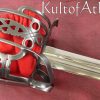This basket hilted Scottish broadsword has a blade of high carbon steel. The basket hilt is crafted from darkened, antique-finished steel and the grip is wrapped in black leather and overlaid with twisted copper wire. The wood-core scabbard is overlaid with black leather and capped with a throat and chape of antique-finished steel.
The words Scot and Bravery are often used in the same sentence – this is no mistake. The Scots at war have well-earned a historical distinction for martial bravery, and this is exemplified in the heedless Highland Charge, whereby Clansmen, would sweep a foe away in wild hand-to-hand combat.
Charging at the foe in a bid to break their line quickly was always a Celtic tradition, but the Scots modified it to suit a new era of gunpowder and shot. In the Highland Charge, the wealthier and better equipped Clan warriors would rush forward and weather the opening musket and artillery fire of their foes. When they came within musket range, the Scots would open fire, not only to disrupt enemy ranks, but also to make a smoke screen from the volley fire, which would provide cover for the warriors behind them.
The Clansmen made all manner of cacophonous noise and were often accompanied by bagpipes – in the face of this sonic assault the discipline of the enemy often wavered and simple reloading become difficult as soldiers stressed at seeing and hearing the wild Highlanders, swords brandished and closing in upon them! As the Scottish Warriors clashed onto the enemy line, they would dash aside clumsy bayonets with their targe shields, and move in close with keen, swift swords and dirks.
Now at an advantage in close combat, they could hack breaks into the enemy formation. Following them and concealed by the smoke would be masses of poorer clansman. Often armed with little more than modified agricultural tools, these lesser Clansmen would swarm into the distressed gaps, hacking aside bayonet-tipped rifles with their heavy lochaber axes. This created mass chaos for an enemy like the English, who relied on disciplined volleys of gunfire. In chaos order falters and the discipline of training is lost – as they go so too does bravery. The success of the Highland Charge relied on putting the foe into flight, desperate to save their skins from the ”savage” Clansmen.
The twilight of the Clans was brought to a swift end at Culloden in 1745, when an ill-timed Highland Charge was faltered by massed artillery. Though the Highlanders broke the line in several places, experienced English troops held their ground, sinking mechanistic volleys of musket fire into the Scots. Losses to the Scottish were grievous, but the greatest price was paid in Scotlands annexation into Britain and the repression of Gaelic culture, which included the outlawing of the iconic Basket-Hilt sword. Many ancestral blades were hidden from confiscation. Henceforth, the Scottish basket hilt sword would be wielded mostly by officers of the Highland Regiments of the British Army and in service to Britain. These army swords would, ironically, be mostly made in England.
The Scottish Basket-Hilt Sword, the sword of the Highland Charge was a wide, dual-edged broadsword or single-edged backsword, durably built and meant to weather the rough of the battle and would cut and thrust decisively. The elaborate basket hilt was not unique to Scotland, but the Scots characteristically lined it with bright cloth and pommel tassles. It is not only very protective of the hand, but it can be used to punch and strike at a foe in close.
The Highland Charge would find its way into the New World, when British Highlanders would counter-charge natives of an Ohio confederation at the 1763 Battle of Bushy Run, scattering them deep into the wood after a tenacious action with basket-hilted swords and bayonets.






















Brian (verified owner) –
I must say, you won’t be disappointed in this piece. The steel furniture is a little darker than the pics, thought I received a Cold Steel at first, but it’s definitely cool. Added the sharpening to it, and was amazed how it sliced through jugs like butter. I cut the little tassel off mine for historical sake. I’m overall pleased with this sword, and everything is tight and solid as it should be